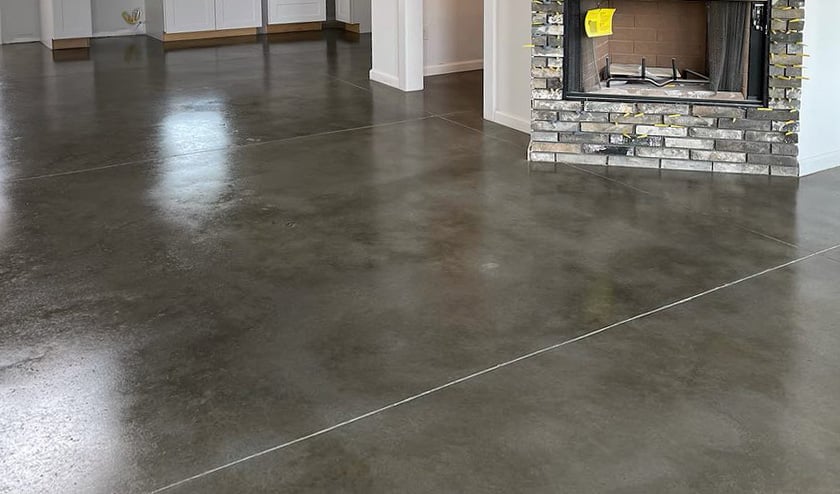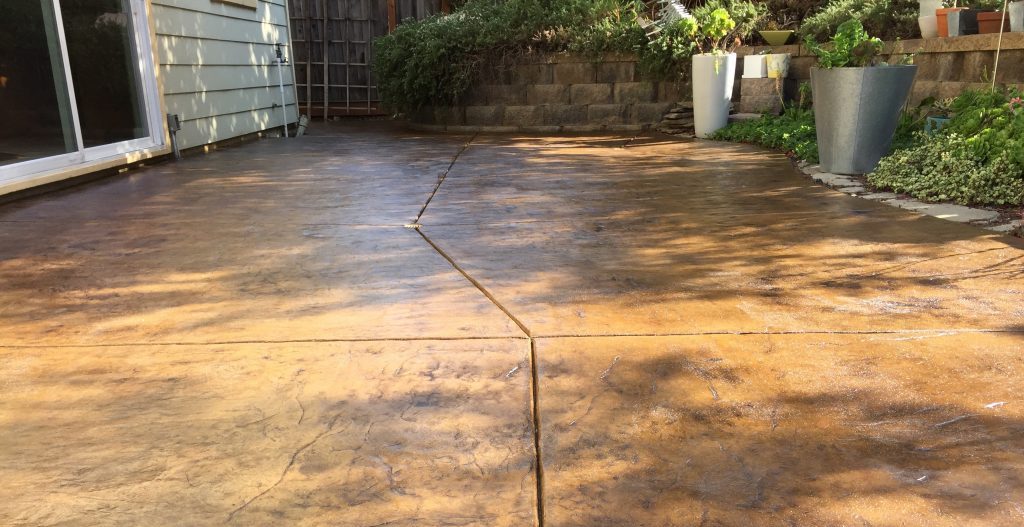Why hiring stained concrete contractors is essential for professional results
Understanding the Various Kinds Of Stained Concrete for Your Next Project
Stained concrete offers numerous choices that provide to different visual and useful requirements. Each kind presents distinctive qualities that affect the final look and resilience of the surface area. Understanding these differences is essential for anybody planning a job. From rich, chain reactions of acid-based stains to the dynamic harmony of solid shade stains, the options can significantly impact the end result. What variables should one consider when choosing the optimal stain for their particular demands?
Overview of Stained Concrete
Stained concrete offers as a functional flooring alternative that can improve the aesthetic allure of different spaces. This method entails applying a tinting agent to the surface area of existing concrete, enabling for a broad range of style opportunities. Stained concrete is popular in both property and commercial settings, offering a resilient and low-maintenance solution that can mimic the appearance of all-natural products like stone or floor tile.
The staining process can be executed using water-based or solvent-based items, each offering distinct visual effects. The last look is influenced by aspects such as the initial concrete surface area, the sort of discolor utilized, and the application approach. Stained concrete not only enhances insides and exteriors but also advertises sustainability by revitalizing existing concrete structures. As a result, it has actually gained traction among homeowners and developers seeking both capability and design in their flooring choices.
Acid-Based Stains: Features and Benefits

One-of-a-kind Shade Variants
Concrete surfaces can change significantly with the application of acid-based stains, which supply a rich scheme of unique color variants. These stains permeate the concrete, reacting chemically to generate vibrant planet tones that vary from deep browns and reds to soft greens and blues. The resulting colors are often variegated, creating a natural, marble-like look that enhances the concrete's personality. Each application returns distinct results because of variants in the concrete's composition and the staining technique utilized, making every project distinct. In addition, acid-based stains can be layered or combined with various other methods to develop tailored styles, allowing for personal expression. This flexibility makes acid-based stains a prominent selection for both domestic and industrial applications.
Chain Reaction Discussed
While lots of aspects add to the efficiency of acid-based stains, the underlying chemical responses play an important function in their special features and advantages. These stains largely contain water, acid, and metal salts. When used to concrete, the acid reacts with the calcium hydroxide in the cement, developing a chemical improvement that causes permanent color changes. The metallic salts penetrate the surface area and bond with the concrete, enabling a wide range of colors and tones. This reaction not just boosts visual charm but also gives sturdiness, making the color immune to fading and wear. In addition, acid-based stains can produce a variegated finish that resembles all-natural stone, further enhancing their appeal for ornamental concrete applications.
Surface Prep Work Value
Attaining ideal outcomes with acid-based stains depends upon complete surface preparation. This crucial action assurances that the concrete surface is tidy, devoid of contaminants, and appropriately profiled for optimal stain absorption. Any type of existing sealers, dust, or oils can hinder the chain reaction that creates the wanted color and coating, resulting in unequal or patchy results.
Prior to applying the stain, the concrete must be mechanically cleansed or pressure cleaned, complied with by a detailed examination for fractures or blemishes that may need repair. Furthermore, confirming the surface area is sufficiently dried out will certainly boost tarnish adherence. By prioritizing these preparatory measures, the longevity and vibrancy of acid-based stains can be considerably boosted, resulting in a much more cosmetically pleasing and durable finish.
Water-Based Stains: Functions and Benefits

Water-based stains permeate the concrete, using an extra transparent coating that highlights the all-natural texture and variations of the surface area under. They are available in a vast selection of colors, permitting imaginative versatility in layout. Furthermore, water-based stains are easier to tidy up, needing only water and soap, which simplifies the application process.
Their fast drying time boosts performance, making them a functional selection for both DIY enthusiasts and experts. On the whole, water-based stains offer an appealing mix of visual versatility and user-friendly residential or commercial properties, making them a prominent alternative for concrete enhancement jobs.
Strong Color Stains: Vivid Choices for a Strong Appearance
Strong shade stains use an effective service for those looking for to create a strong and lively visual on concrete surface areas. These stains give a consistent pigmentation that can drastically click here to find out more improve the aesthetic charm of floors, outdoor patios, and driveways. Offered in a large range of tones, solid color stains permit creative expression, accommodating different layout choices.
Among the vital advantages of strong shade stains is their ability to conceal blemishes, offering a fresh and polished look to maturing concrete - stained concrete contractors. In addition, their formula typically consists of UV-resistant buildings, ensuring long life and shade retention even in harsh climate condition
Application is simple, calling for very little prep work of the concrete surface. Once used, solid shade stains can be sealed for included defense and luster, additional boosting their aesthetic top quality. With their lively options, strong color stains are a superb option for those intending for an impactful and cohesive layout.
Semi-Transparent Stains: Achieving Depth and Measurement
Semi-transparent stains provide a distinct approach to improving concrete surfaces by supplying deepness and measurement through numerous shade alternatives. Comprehending the application techniques is crucial for accomplishing the desired impact, while correct maintenance techniques guarantee long life. This section will explore these vital aspects to take full advantage of the advantages of semi-transparent staining.
Shade Options Available
A variety of shade options exists for semi-transparent stains, enabling property owners and designers to improve the all-natural appeal of concrete surface areas. These stains come in a variety of hues, from earthy tones like browns and terracottas to lively shades such as blues and eco-friendlies. The semi-transparent nature of these stains allows the underlying concrete to reveal via, developing an one-of-a-kind deepness and dimension that can complement numerous design appearances. Additionally, integrating various shades can create custom-made shades, making it possible for a tailored try to find each job. This adaptability makes semi-transparent stains a preferred selection for both interior and outside applications, as they can balance with surrounding aspects while including aesthetic rate of interest to ordinary concrete.
Application Strategies Discussed
To accomplish the wanted depth and measurement with semi-transparent stains, proper application techniques are important. First, surface preparation is vital; the concrete must be clean and without any pollutants. This typically involves power cleaning and repairing any cracks. Next off, picking the ideal applicator, such as a sprayer, roller, or brush, can affect the final look. Sprayers enable an extra even application, while rollers can help attain texture. It is essential to use the stain in slim, even layers, enabling each layer to dry prior to adding an additional. Manipulating the application strategy, such as differing pressure or making use of different tools, can develop special impacts. Sealing the stained surface boosts the vibrancy of the colors while giving defense.
Upkeep Best Practices
Routine upkeep is important for maintaining the charm and honesty of surface areas treated with semi-transparent stains. To maintain these surface areas, regular cleaning is essential. Using a pH-neutral cleaner and a soft-bristle mop will certainly assist get rid of dirt and particles without damaging the discolor. It is advisable to prevent harsh chemicals, as they can break down the stain's appearance. In addition, periodic resealing every one to three years can secure against wear and fading. This process includes cleaning the surface area completely and applying a suitable sealer designed for stained concrete. Home owners ought to likewise check for any signs of discoloration or damages and address these issues immediately to assure lasting vibrancy and toughness. Adhering to these ideal practices will enhance the general life-span of semi-transparent stained surface areas.
Results and Techniques: Personalizing Your Stained Concrete
Customizing stained concrete involves an array of strategies that enhance both appearances and functionality. Amongst these approaches, layering different tarnish shades can develop depth and complexity, permitting one-of-a-kind aesthetic effects. Techniques such as acid staining offer a variegated appearance, while water-based stains provide a see it here more uniform appearance.
In addition, including attractive patterns, such as stenciling or inscription, can better individualize the surface area, adding intricate layouts that deal with private tastes. Texturing the concrete, whether via marking or broom surfaces, introduces responsive components that not just enhance grip yet likewise improve visual passion.
Using sealers can magnify the shade vibrancy and offer defense against wear. Personalization methods extend past simple color; they can transform a basic concrete piece into a stunning centerpiece, making it suitable for both residential and industrial spaces. Via cautious option of effects and techniques, stained concrete can accomplish a truly customized appearance.
Upkeep and Durability of Stained Surfaces
Although stained concrete surface areas are understood for their durability and visual appeal, preserving their integrity is vital for making sure longevity. Regular cleaning is essential; sweeping and wiping with a pH-neutral cleaner helps stop dust buildup and discoloration. In addition, applying a sealer every few years can secure the surface from wetness, chemicals, and UV damage, thereby improving its lifespan.
It is likewise crucial to resolve any cracks or chips without delay. Small repair work can alleviate more wear and tear, protecting the aesthetic and architectural top quality of the surface area. For outdoor stained concrete, seasonal upkeep, such as removing snow and ice, is needed to stop surface area damage from freeze-thaw cycles.
Often Asked Questions
Can I Stain Existing Concrete Surfaces or Only New Ones?
The inquiry of whether existing concrete surface areas can be stained develops often. It is certainly possible to tarnish both new and old concrete, offered the surface is properly ready and devoid of impurities for suitable bond.
For how long Does the Discoloration Process Usually Take?
The staining procedure generally takes one to 3 days, depending upon variables such as surface area prep work, sort of tarnish, and weather. stained concrete company. Treating time might prolong past preliminary application, influencing the general period substantially
Is Stained Concrete Safe for Outdoor Usage?
Stained concrete is normally safe for outside usage, offered it is properly secured. This securing safeguards versus wetness and UV damages, making sure sturdiness and safety and security, while additionally improving the visual appeal of outside spaces.
Can I Use Numerous Stain Layers for Various Results?
Applying numerous stain layers can accomplish diverse results on stained concrete. Nonetheless, it is necessary to guarantee compatibility between stains and enable proper drying out time in between applications to stay clear of unintentional responses or staining.
Are There Any Kind Of Shade Limitations for Stained Concrete?
Shade limitations for stained concrete mostly rely on the kind of tarnish used, with water-based stains offering a wider palette contrasted to acid-based stains. stained concrete company. However, achieving dynamic colors may require careful option and application methods